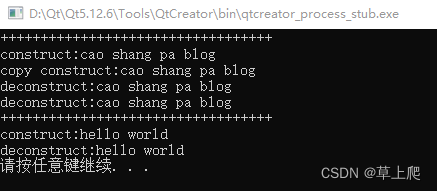emplace操作是C++11新特性,新引入的的三个成员emplace_front、emplace 和 emplace_back,这些操作构造而不是拷贝元素到容器中,这些操作分别对应push_front、insert 和push_back,允许我们将元素放在容器头部、一个指定的位置和容器尾部。
两者的区别
当调用insert时,我们将元素类型的对象传递给insert,元素的对象被拷贝到容器中,而当我们使用emplace时,我们将参数传递给元素类型的构造函,emplace使用这些参数在容器管理的内存空间中直接构造元素。
一个例子
MyString.h
#ifndef MYSTRING_H
#define MYSTRING_H
#include <iostream>
class MyString
{
public:
MyString(const char *str = NULL);// 普通构造函数
MyString(const MyString &other);// 拷贝构造函数
~MyString(void);// 析构函数
MyString & operator = (const MyString &other);// 赋值函数
private:
char *m_data;// 用于保存字符串
};
#endif // MYSTRING_HMyString.cpp
#include "MyString.h"
#include <iostream>
#include <string.h>
//普通构造函数
MyString::MyString(const char *str)
{
if (str == NULL)
{
m_data = new char[1];
*m_data = '\\0';
}
else
{
int length = strlen(str);
m_data = new char[length + 1];
strcpy(m_data, str);
}
std::cout<<"construct:"<<m_data<<std::endl;
}
// String的析构函数
MyString::~MyString(void)
{
std::cout<<"deconstruct:"<<m_data<<std::endl;
delete[] m_data;
}
//拷贝构造函数
MyString::MyString(const MyString &other)
{
int length = strlen(other.m_data);
m_data = new char[length + 1];
strcpy(m_data, other.m_data);
std::cout<<"copy construct:"<<m_data<<std::endl;
}
//赋值函数
MyString & MyString::operator = (const MyString &other)
{
std::cout<<"copy assignment"<<std::endl;
if (this == &other)
return *this;
if (m_data)
delete[] m_data;
int length = strlen(other.m_data);
m_data = new char[length + 1];
strcpy(m_data, other.m_data);
return *this;
}
main.cpp
#include <vector>
#include "mystring.h"
int main()
{
{
std::cout<<"++++++++++++++++++++++++++++++++++"<<std::endl;
std::vector<MyString> vStr;
// 预先分配,否则整个vector在容量不够的情况下重新分配内存
vStr.reserve(100);
vStr.push_back(MyString("cao shang pa blog"));
}
{
std::cout<<"++++++++++++++++++++++++++++++++++"<<std::endl;
std::vector<MyString> vStr;
// 预先分配,否则整个vector在容量不够的情况下重新分配内存
vStr.reserve(100);
vStr.emplace_back("hello world");
}
system("pause");
return 0;
}输出结果

从结果可以看出,vStr.push_back(MyString("can ge ge blog")) 这个语句首先执行了构造函数,构造一个临时对象,接着执行拷贝构造将临时对象复制到vector,最后销毁临时对象和vector中的元素。而emplace_back只调用一次构造函数和一次析构函数。两相对比,效率上的提高不言而喻
© 版权声明
文章版权归作者所有,未经允许请勿转载。
THE END









![[转]我国CAD软件产业亟待研究现状采取对策-卡核](https://www.caxkernel.com/wp-content/uploads/2024/07/frc-f080b20a9340c1a89c731029cb163f6a-212x300.png)






